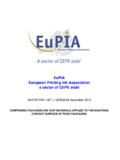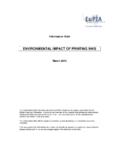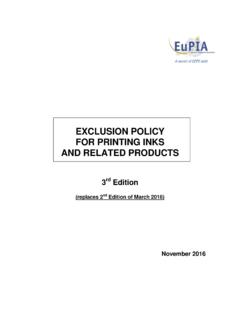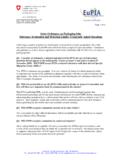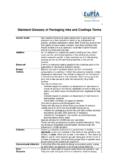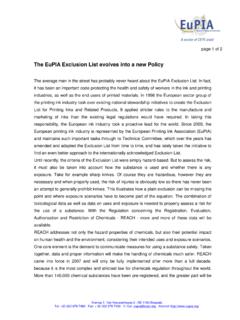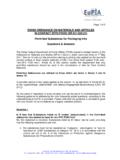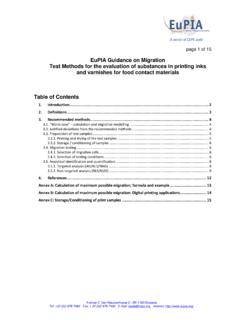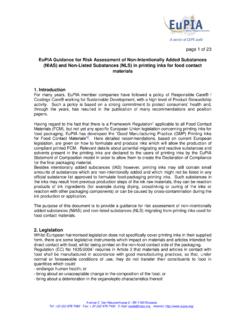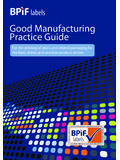Transcription of Information leaflet Printing Inks for Food Packaging
1 Page 1 of 8. Information leaflet Printing inks for food Packaging 1. Introduction food Packaging is printed to provide Information to the final consumer in accordance with Directive 2000/13/EC relating to the labelling (concerning contents, food ingredients and nutrition facts) as well as the presentation and advertising of foodstuffs. In addition Printing is carried out for decorative and protective reasons. There are exceptional instances where Printing inks are applied on the inner side of the Packaging or on inserts, for promotional purposes, and intentionally have direct food contact. These cases are only negligible in volume, and therefore this Information paper mainly deals with Printing inks applied on the non- food contact surface of food Packaging ( Packaging inks ). The definition of Packaging inks also includes primers, lacquers and overprint varnishes applied by a Printing and/or coating process, such as flexography, gravure, letterpress, offset, screen, non-impact Printing or roller coating.
2 2. Legal requirements Framework Regulation (EC) No 1935/20041 related to materials and articles intended to come into contact with foodstuffs provides the basis for the assurance of a high level of protection of human health and of consumers' interests in relation to food Packaging , whether printed or not. The manufacturer of the final Packaging has the responsibility for the compliance of the material and article with the legal requirements laid down in Article 3: Materials and articles must be manufactured in compliance with good manufacturing practice so that, under their normal or foreseeable conditions of use, they do not transfer their constituents to foodstuffs in quantities which could: a) endanger human health;. b) bring about an unacceptable change in the composition of the food ;. c) bring about a deterioration in the organoleptic characteristics thereof.
3 1. REGULATION (EC) No 1935/2004 OF THE EUROPEAN PARLIAMENT AND OF THE COUNCIL of 27 October 2004 on materials and articles intended to come into contact with food and repealing Directives 80/590/EEC and 89/109/EEC, OJEU L338. of 13. 11. 2004. Avenue E. Van Nieuwenhuyse 6 - BE-1160 Brussels Tel: +32 (0)2 676 7480 - Fax: + 32 (0)2 676 7490 - E-mail: - Internet: Page 2 of 8. The GMP Regulation 2023/20062 lays down rules on good manufacturing practice for materials and articles intended to come into contact with food . It introduces general rules for all business operators in the supply chain, and specifies that quality assurance and control systems are established and implemented. All Printing inks intended for use on food Packaging are in the scope of this Regulation. The Annex introduces detailed rules, which relate to processes involving the application of Printing inks to the non- food contact side of a material or article.
4 There is not yet any specific EU legislation concerning Printing inks for food Packaging , with the exception of Directive 2007/42/EC relating to materials and articles made of regenerated cellulose film, which states that the printed surface of regenerated cellulose film must not come into contact with food . Switzerland amended their Ordinance on Materials and Articles in Contact with food 3. with provisions on food Packaging inks . This introduced a list of permissible substances . The amendment came into force on 1st April 2008 with a transitional period of two years; hence the requirement has been applicable since April 2010. In May 2011, the Annex of this Swiss Ordinance was changed and some new evaluated substances were included. The main specific measure pursuant to the Framework Regulation is Regulation (EU).
5 No 10/2011 relating to plastic materials and articles intended to come into contact with foodstuffs. It lays down an overall migration limit (OML) of 60 mg/kg food or 10 mg/dm . of surface area. In addition, specific migration limits (SML) or maximum contents in the material or article (QM) are set for individual substances. The Regulation contains a positive list of monomers and other starting substances as well as additives. Substances used only in the manufacture of Printing inks are not listed, and thus Packaging inks are not under the scope of this Regulation. However, for ink components which are listed, the relevant restrictions such as specific migration limits (SML) or maximum content (QM) have to be met. 3. Controls for food Packaging Although raw materials for Packaging inks applied on the non- food contact surface are selected whenever possible from the relevant listings (such as the Plastics Regulation (EU) No 10/2011 and its amendments, the Regenerated Cellulose Film Directive 2007/42/EC, or national legislation and recommendations, and US FDA Regulations), they are not formulated, manufactured or marketed for direct food contact and, as such, they are not exclusively made from raw materials intended for this purpose.
6 2. Commission Regulation (EC) No 2023/2006 of 22 December 2006 on good manufacturing practice for materials and articles intended to come into contact with food , OJEU L384 3. Ordinance on Materials and Articles in Contact with food , Verordnung des EDI ber Bedarfsgegenst nde, 7. M rz 2008 SR. ( ). Avenue E. Van Nieuwenhuyse 6 - BE-1160 Brussels Tel: +32 (0)2 676 7480 - Fax: + 32 (0)2 676 7490 - E-mail: - Internet: Page 3 of 8. The following controls should be in place within the Packaging chain at the ink manufacturing stage, as well as the application by the converters, in order to minimise the migration of substances into food (no-migration principle), and herewith to allow compliance of the final printed material and article with the existing legal provisions and to ensure the consumers' safety in terms of health.
7 Formulation and manufacture of Packaging inks Printing ink manufacturers that are members of EuPIA4 commit that they will follow the eupia Guideline on Printing inks applied to the non- food contact surface of food Packaging materials and articles ( ), which sets out in full the responsibilities of the ink manufacturers within the Packaging chain. food Packaging inks are formulated and manufactured taking into account many individual and varying parameters relating to the substrate, application and end-use. They are designed to minimise the potential for transfer of ink components into food by migration or set-off, whilst meeting the end use requirements. An Inventory List comprising of raw materials of Packaging inks applied to the non- food contact surface of food Packaging has been published on the eupia website.
8 Selection of raw materials The raw materials5 are selected in accordance with the Selection scheme for Packaging ink raw materials of the eupia Guideline. They do not belong to the following categories (exclusion criteria): a) classified as carcinogenic , mutagenic or toxic for reproduction categories 1. and 2, according to the provisions of Directive 67/548/EEC on dangerous substances6 (categories 1A and 1B according to CLP, Regulation (EC) No 1272/2008). Category 3 substances (CLP Category 2) are only used after a migration study has confirmed that migration levels are either within published SML or TDI. values, or are below an intake (threshold of toxicological concern) of g/person/day7. Category 3 reproductive toxicants (R62, R63; H361f, H361d). 4. eupia : European Printing Ink Association (a sector of CEPE aisbl).
9 5. Raw materials may contain starting substances and/or components which are CMR or T, T+, but at levels which do not trigger a classification of the raw material itself as CMR Cat. 1 or 2 (CLP 1A or 1B) or T, T+. Any migration of these into foodstuffs must comply with any relevant limit. 6. This Directive has been last amended by Directive 2009/2/EC (31. ATP) OJEU L11 ; but Regulation (EC) No 1272/2008. on Classification, Labelling and Packaging of Substances and Mixtures (OJEU L 353 of 31. 12. 2008) in force since 20 January 2009 will repeal it on 1 June 2015. 7. ILSI, Threshold of Toxicological Concern (TTC), Monograph, 2005, Avenue E. Van Nieuwenhuyse 6 - BE-1160 Brussels Tel: +32 (0)2 676 7480 - Fax: + 32 (0)2 676 7490 - E-mail: - Internet: Page 4 of 8. without a published limit may be used if the migration levels are confirmed to be not detectable (with a detection limit of mg/kg food ).
10 B) classified as toxic (T) and very toxic (T+);. c) colourants based on and compounds of antimony8, arsenic, cadmium, chromium (VI), lead, mercury, selenium;. d) all substances identified in the REACH Regulation (EC) No 1907/2006, Title VIII. and Annex XVII (restrictions on the manufacturing, placing on the market and use of certain dangerous substances, mixtures and articles) and its amendments, if their use in a Packaging ink would lead to an infringement of Article 3 of the Framework Regulation. These criteria are under regular review and updated when necessary. Packaging inks are formulated and manufactured in accordance with the eupia Good Manufacturing Practices available at Purity requirements The colourants used meet the purity requirements of the Council of Europe (CoE). Resolution AP(89)1 on the use of colourants in plastic materials coming into contact with food .

